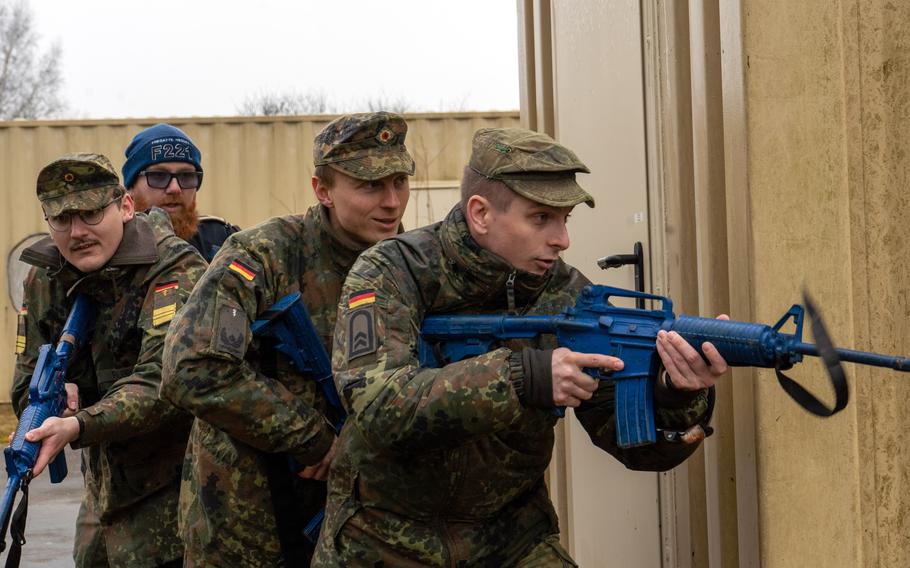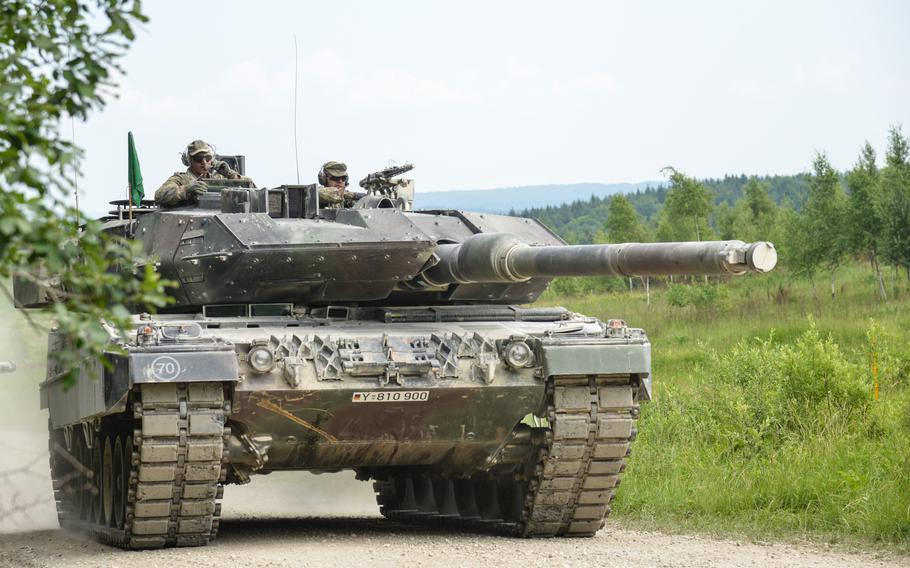
German soldiers practice clearing a room during an exercise at Grafenwoehr Training Area, Germany, Feb. 13, 2025. Friedrich Merz, likely Germany's next chancellor, says Europe needs to prepare to go it alone without the United States. (Carlos Marquez/U.S. Army)
STUTTGART, Germany — The man poised to be Germany’s next leader delivered a jolt this week when he warned that the demise of NATO in its current form could be at hand and said Europe must chart a military course separate from the United States.
Friedrich Merz’s center-right Christian Democratic Union party won Sunday’s federal election, positioning him to lead a government that will grapple with how to deter Russian aggression in an era where American largesse is no longer a guarantee.
“My absolute priority will be to strengthen Europe as quickly as possible so that step by step, we can really achieve independence from the USA,” Merz said on a post-election debate show Sunday.
“I never thought I would have to say something like this on a television program,” added Merz, a longtime advocate of close relations with Washington.
Germany and its neighbors would face a daunting challenge in funding and fielding an independent defense capable of turning back Russian forces.
At a minimum, Europe will need to field 50 new combat brigades and some 300,000 troops to offset what the United States would be expected to contribute in the event of a Russian attack, according to an analysis by Bruegel, a Brussels-based think tank.
To prevent a rapid Russian breakthrough in the Baltics, for example, Europeans would need a minimum of 1,400 tanks, 2,000 infantry fighting vehicles and 700 artillery systems, the report said.
“This is more combat power than currently exists in the French, German, Italian and British land forces combined,” stated the report, published Friday.
Europeans also would need to surge beyond the “barebones stockpiles” of munitions currently available. An estimated 1 million 155 mm shells would be the minimum for a stockpile large enough for 90 days of high-intensity combat, the report said.
NATO officials have warned that Russia’s wartime economy could have the country in a position to threaten allies within five years.
Bruegel’s analysis detailed numerous other shortfalls that allies would struggle to fill. More aviation and transport assets, missile and drone warfare capabilities and intelligence systems for identifying enemy targets would be required.

German soldiers drive their Leopard 2A6 tank during a competition in 2018 at the Grafenwoehr Training Area. Friedrich Merz, likely Germany's next chancellor, says Europe must prepare to guarantee its security without the United States. (Rolyn Kropf/U.S. Army)
Bruegel said the various necessities would cost more than $250 billion annually, or roughly 3.5% of gross domestic product, for European countries.
There’s debate about whether Europe is up to such a task. There also are questions about whether there is enough time to act, given how far behind the Europeans are in matching Russia’s military output.
Andrew Michta, an expert on European security at the Atlantic Council think tank, said the “delta” between the level of Russia’s force reconstitution and the many deficiencies in most of Europe’s militaries means “the risk of war in Europe is real.”
And the neglect of Europe’s industrial base over the years means it will take a “decade before any real capabilities can be fielded,” Michta said Monday on the social media platform X.
Such circumstances mean that there is no substituting American involvement on the Continent, Michta said.
Others counter that the United States has become too unreliable.
“Europe can’t afford to wait and see if the U.S. will back us,” said Benjamin Tallis, director of the Berlin-based Democratic Strategy Initiative. “We can’t rely on the U.S. — from now, until they fix their problem,” a reference to Trump’s approach to Europe.
In a back-and-forth with Michta on X on Monday, Tallis said Europe should turbocharge investment in high-end capabilities, such as precision munitions, to counter Russia’s mass rather than try to replicate the American military.
Despite being bogged down in Ukraine and suffering casualties estimated in the hundreds of thousands, Russia now fields a larger military than it did at the start of the war three years ago. And it is churning out munitions at a faster pace than all of Europe combined.
In 2024 alone, Russia produced an estimated 1,550 tanks, a 220% increase from 2022, Bruegel said.
Military analysts and allies along Russia’s periphery, such as Poland and the Baltic states, have warned that Russian President Vladimir Putin’s territorial ambitions could eventually extend beyond just Ukraine.
Putin himself has compared his campaign in Ukraine to the 18th-century empire expansions of Peter the Great.
President Donald Trump’s recent assertions that Ukraine is responsible for the war there and that Ukrainian President Volodymyr Zelenskyy is a dictator have rattled allies already wary about the American president’s long-held skepticism about the value of NATO.
While many allies are anticipating significant U.S. troop reductions in Europe at some point, Trump hasn’t made his position clear yet.
On Sunday, Merz said he was uneasy about the future.
As allies prepare for a NATO summit in June, the question is “whether we will still be talking about NATO in its current form or whether we will have to establish an independent European defense capability much more quickly,” Merz said.